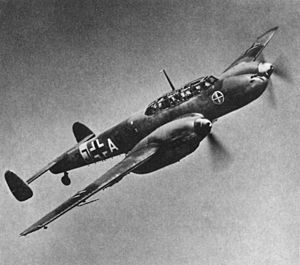Messerschmitt Bf 110 facts for kids
Quick facts for kids Messerschmitt Bf 110 |
|
|---|---|
 |
|
| Role | Fighter aircraft |
| Manufacturer | Messerschmitt |
| First flight | 12 May 1936 |
| Introduction | 1937. |
| Retired | 1945 (Luftwaffe) |
| Primary user | Luftwaffe |
| Number built | Estimated 6,170 |
The Messerschmitt Bf 110 was a powerful fighter aircraft with two engines. It was designed in Germany in 1935. Its main job was to fly long distances and protect other planes. The first one flew on May 12, 1936.
The German Luftwaffe (air force) used this plane a lot during World War II. In Germany, people called it Zerstörer, which means "the destroyer". Early in the war, the Bf 110 helped Germany win many battles. This changed when they attacked Great Britain.
Contents
The Bf 110 in World War II
The Messerschmitt Bf 110 was an important plane for Germany during the war. It was known for its strong firepower. It could carry many machine guns and cannons. This made it very good at attacking other planes and ground targets.
Challenges in the Battle of Britain
During the Battle of Britain in 1940, the Bf 110 faced tough challenges. It was slower and less agile than British planes like the Supermarine Spitfire and the Hawker Hurricane. The Hurricanes could turn much faster than the Bf 110. The Spitfires were also much quicker in a straight line.
Because of these problems, the Bf 110 often needed protection from other German fighters. This was especially true when flying over Britain. By October 1940, many Bf 110 units were moved away from the English Channel. The Luftwaffe then focused more on night bombing.
Becoming a Night Fighter
Even with its weaknesses as a day fighter, the Bf 110 found a new important role. It became a very effective night fighter. These planes were used to find and shoot down enemy bombers at night. They were fitted with special radar equipment to help them see in the dark.
One of the most famous night fighter pilots was Major Heinz-Wolfgang Schnaufer. He was Germany's top night fighter ace. He claimed 121 victories while flying a Bf 110. This shows how successful the plane was in its night fighting role.
Images for kids
-
Bf 110s in flight above Budapest. 1944
-
Bf 110 E-1, Ergänzungs-Schlachtgruppe, Dęblin-Irena (Poland 1942).
-
A Bf 110 G-4 night fighter at the RAF Museum in London.
-
Bf-110 G-4 cockpit; RAF Museum London.
-
Bf 110 Werk Nr. 5052, Deutsches Technikmuseum Berlin. The noseart emblem on this aircraft is the dachshund of 10.(Z)/JG 5.
See also
 In Spanish: Messerschmitt Bf 110 para niños
In Spanish: Messerschmitt Bf 110 para niños











